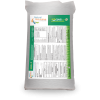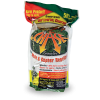Moles are small mammals classified as insectivores who both feed and live underground. When searching for food, moles burrow in lawns with suitable conditions. They can be quite active, tunneling up to 15 feet per hour.
The presence of moles is easier to spot in the spring and fall, when activity occurs just a few inches below the surface of a lawn. During these times, longer soil ridges are indicative of mole activity. In the summer and winter, moles burrow at a deeper level. The presence of moles is noticed during these seasons by mounds of dirt on a lawn, left after moles emerge on the surface.
Mole diets consist of earthworms, grubs, beetles, ants and other insect larvae. Large mole damage may suggest an abundance of grubs in your lawn, which can be even more destructive. While moles don’t feed directly on turf, grubs eat the roots of your lawn, killing the grass above. If dead patches of grass accompany mole ridges or mounds, this may be an indication of abundant grubs. Use Natural Alternative® grubGONE!® to eradicate grub populations and deprive existing moles of a major food source.
Detecting mole damage early is key to successful eradication. Watch for signs of disturbed soil ridges or mounds. If you spot mole activity, utilize Natural Alternative® Chase Mole Control to deter moles humanely. As a biodegradable and environmentally friendly deterrent, Chase Mole Control irritates the digestive system of moles, encouraging mole populations to vacate without harming the moles or your lawn.



